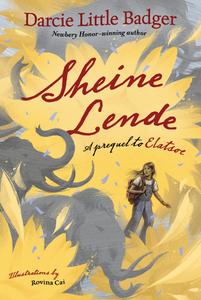
|
|
| Darcy Little Badger (Kenny Goldberg Photography) |
|
Darcie Little Badger is a Lipan Apache writer who has a Ph.D. in oceanography. Little Badger's work--including her second fantasy novel, A Snake Falls to Earth, which received the Newbery Honor and was longlisted for the National Book Award--highlights a rich and dynamic Lipan Apache culture and develops complex worlds. Her first novel, Elatsoe, and its prequel, Sheine Lende (Levine Querido, $19.99; reviewed in this issue), are young adult fantasies that are at once steely and heartfelt. Here Little Badger speaks with Shelf Awareness about strong women, intergenerational ties, Lipan Apache perseverance, and extradimensional magic.
How would you describe Sheine Lende to readers?
Sheine Lende tells the story of Shane, a girl in 1970s Weird Texas ("weird" as in her version of Texas is full of monsters, ghosts, and magic). Shane's mother goes missing during a search-and-rescue effort, so Shane has to travel across the country--and out of this world--to find her. Fortunately, she's assisted by two friends, her chaotic neutral (or evil? or good?) grandfather, and a ghost bloodhound. So, it's a missing-person mystery with fantastic elements, strong female friendships, and complicated family relationships. But at its heart, the story is also about surviving as a Lipan Apache girl in a world of erasure, tragedy, and cruelty, with a lot of basis in reality and historical events of the '70s. Without spoilers, the last quarter of the book is symbolic of Shane's inner struggle with despair, while also being her literal journey through a ghostly tundra full of prehistoric mammals.
Sheine Lende is a prequel to your highly acclaimed debut novel, Elatsoe. Why did you choose to go back in time and tell the story of Ellie's grandmother, Shane?
After I wrote A Snake Falls to Earth, Arthur Levine (the man behind my publisher Levine Querido) asked whether I'd be interested in returning to the world of Elatsoe. The answer was "Yes, absolutely." There were tons of worldbuilding aspects--such as the impact of fairy rings and extradimensional magic on Earth--I didn't get to include in the first book. However, Ellie's story felt complete.
It seemed natural, then, to write about one of her ancestors. The women in Ellie's maternal line (her mother, grandmother, great-grandmother... all the way to six-great-grandmother) learned the ability to raise animal ghosts and used that power for heroic ends. So, I wondered: What were their adventures? Whose story should I tell?
Ultimately, I decided to develop the story of Sheine Lende (Shane), Ellie's grandmother. As a teenager during the 1970s, Shane experienced a unique set of challenges; the tragic events she experienced are based on real-world history very few people learn. This was my opportunity to shine a light on the perseverance of Lipan Apache people throughout the 20th century.
Plus, I have the perfect beta reader: my mother was a teenager in 1970s Texas!
 I love the way your America is so close to our "real" world, but there is also--in your words--"powerful magics." Why did you choose to have a world so close to our own, but with magic?
I love the way your America is so close to our "real" world, but there is also--in your words--"powerful magics." Why did you choose to have a world so close to our own, but with magic?
As a genre writer, I appreciate that fantasy enables me to explore and process the human condition and real-world events with tools of pure imagination. For example, in Sheine Lende, the mimic fairy rings behave like invasive plant species, whose impacts I studied in college. And I'm able to make their environmental and social damage very clear by giving them these chaotic teleportation powers, which sap the organic life from the soil.
Ghosts, especially ghost animals, play an outsize role in Sheine Lende (and Elatsoe). Can you explain why?
I've always enjoyed a good ghost yarn; blame my formative years reading Goosebumps and Scary Stories to Tell in the Dark. When I was a teenager, I wrote a short story about a haunted house. Three kids investigated the place and learned that the ghost of a parrot was trapped within its attic. They freed the poor critter by opening the door of its birdcage, long forgotten among other abandoned junk. The ghost parrot could speak (a few phrases) and cause gusts of wind. I wondered: What supernatural powers would other species have? Could a ghost dog do amazing tricks?
But in Sheine Lende (and Elatsoe), ghosts have a symbolic role, too. Growing up I never learned about my people in school, despite our major role in Texas history. And the first time I read the word "Lipan Apache" in a book, it claimed we were all dead. I thought to myself: What does that make me? My community, culture, and family were vibrant and present in my life, yet the world treated us like we'd gone extinct. It kinda felt like I was a ghost, and human ghosts are terrible, unnatural things. They have no home. They are nothing but pain.
This is the despair Sheine Lende wrestles with, thematically.
My novels make it clear: we are still here.
How much are you present in your characters?
Honestly, not much. I'd probably get bored--it's too much fun to put myself in the heads of different people (or even species!) and engineer their adventures. That said, there's sometimes an element of wish fulfillment to my writing. For example, Shane is calm and proactive in crisis situations. Am I? Errrrm. Depends on the crisis, but I doubt I'd survive an attack by a prehistoric lion. I wish I had Shane's survival skills, though.
What do you hope readers will take away from Sheine Lende?
Above all, I hope the story will connect with readers and be an enjoyable read. If it also inspires them to fight through their own difficulties, whatever they may be, that'd be wonderful.
What are you working on now? Can readers hope for another book in this world?
I can definitely see a third book in the Elatsoeverse--maybe this one can span many generations! Ellie, Shane, and Six-Great all part of the same overarching plot? Right now, I'm working on a couple other projects (for middle-grade readers and adult readers), and my fourth YA book will be a standalone about cousins and the winged harbinger of doom.
Is there anything else you'd like readers to know?
Guinea pigs are born with their eyes open and ready to run. --Lynn Becker, reviewer, blogger, and children’s book author

